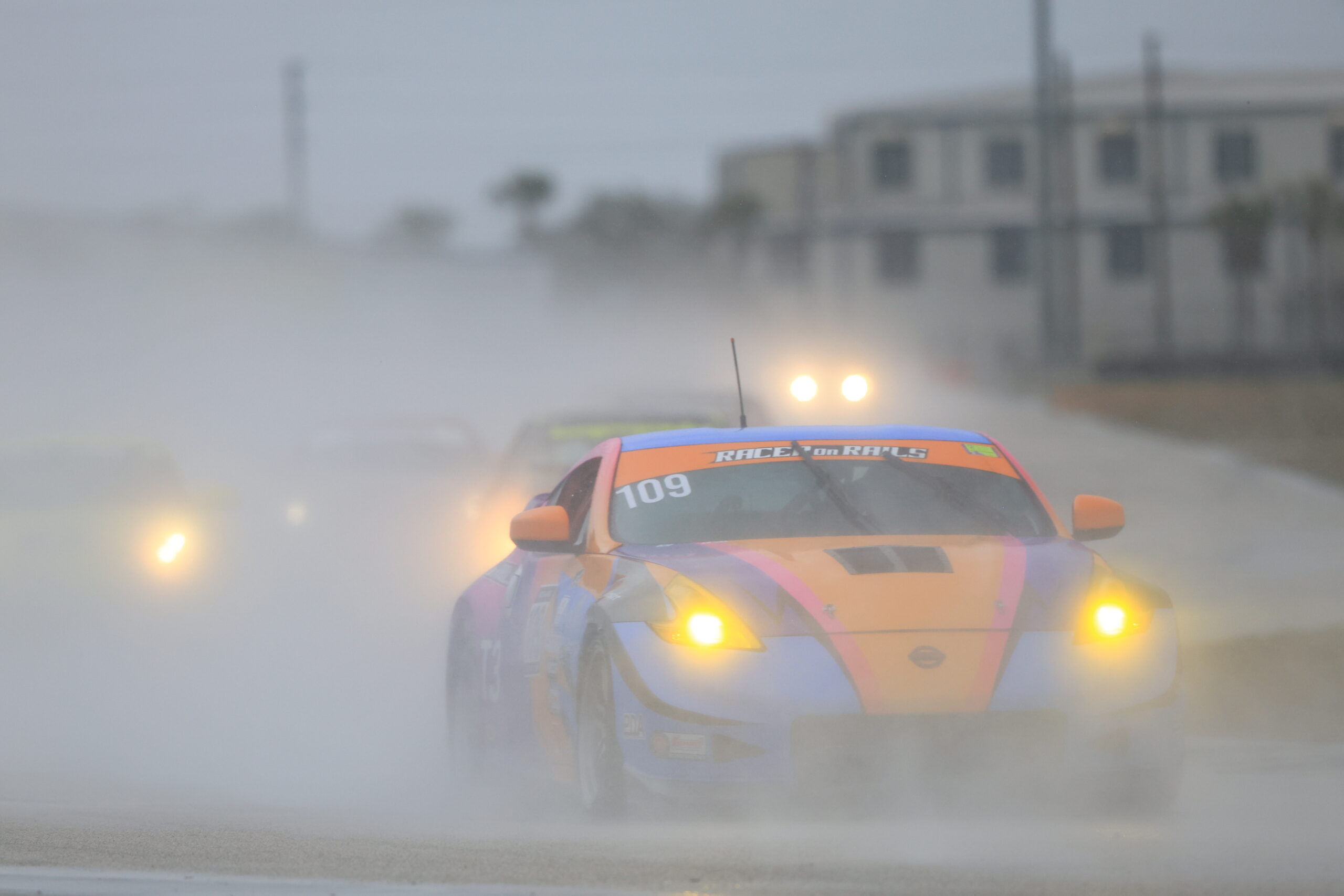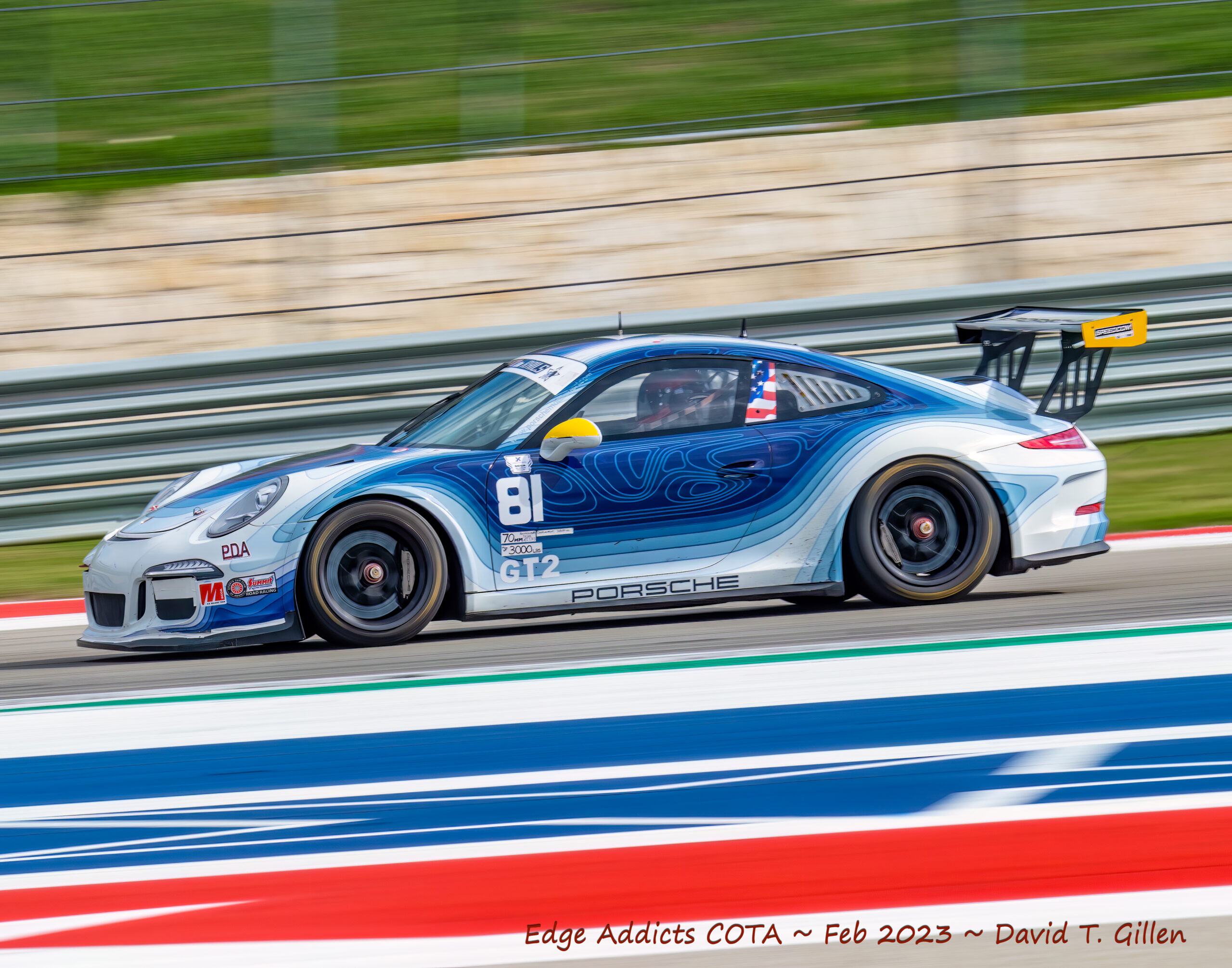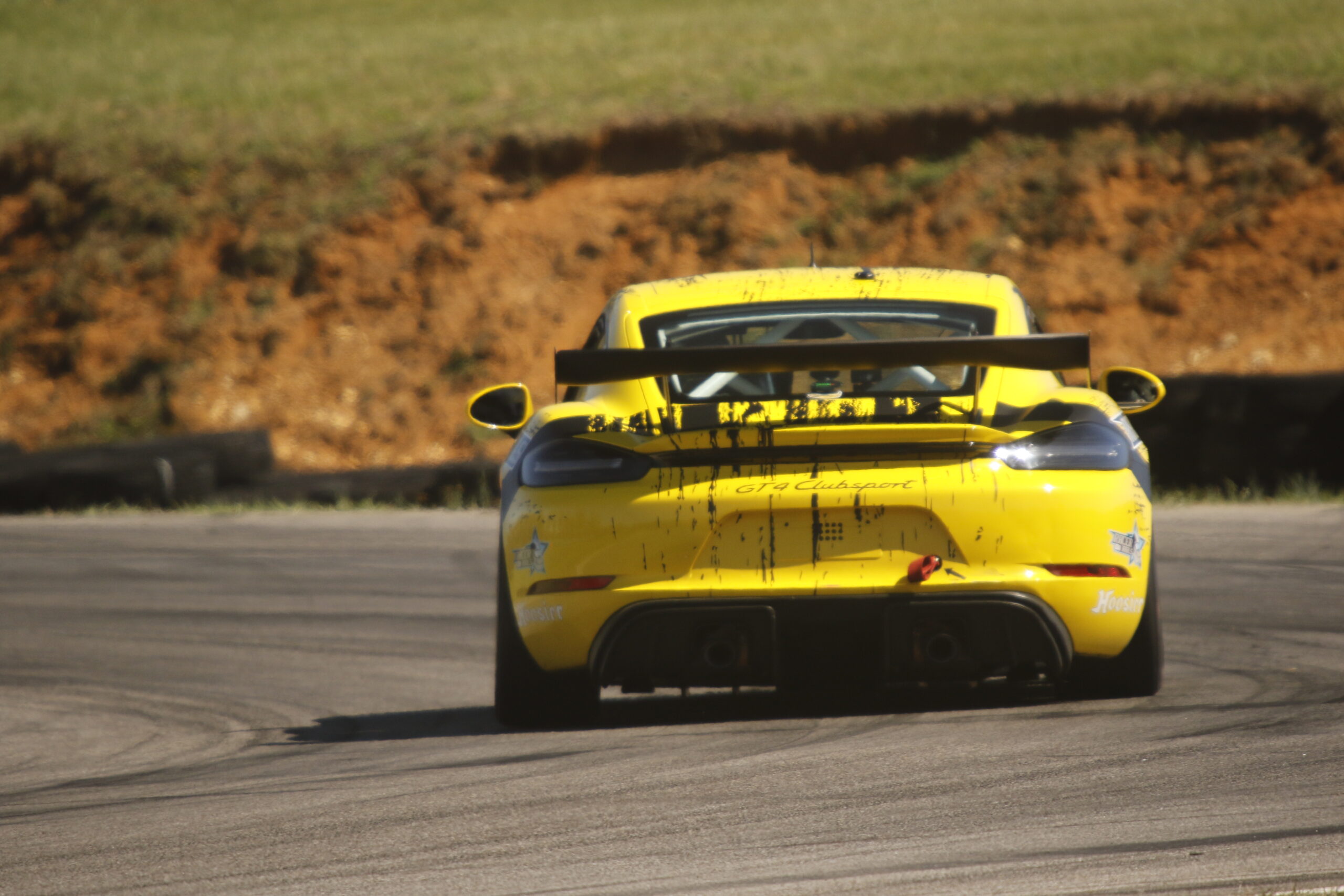
After a very short “off-season” coming off the 2023 SCCA Runoffs held at Virginia International Raceways for the second year in a row, the team regrouped, got cars turned and headed to Sebring, FL for the first race of the year.
With a new racing year, we have some changes on the team. For the first race, we brought down Simon Asselin in his 991.1 Porsche GT3 Cup Car, racing in the GT2 class for a second year in a row. Dave Orem has moved from a BMW Spec E46 in Touring 3 class, to the 2023 Touring 3 National Championship winning BMW Z4 M. Gama Aguilar returned in his freshly rebuilt Nissan Nismo 370Z, also competing in Touring 3 class.
Ann Doherty is in the middle of transitioning into a new car and new class for 2024 – stay tuned for updates! Thad Berger will be focusing on his Porsche Cayman GT4 MR in Touring 1 class but will miss the first couple of races and join the tour at Road Atlanta in March.
Simon Asselin Porsche 911 GT3 Cup Car in GT2 Class
Simon took official delivery and got his first laps in his Cup Car at this race last year. Since last year, Simon has had several solid race weekends, upgraded suspension with Motion Control Suspension (MCS) 3-ways, experimented with different tires, and iterated on both dry and wet setups. With a stronger foundational knowledge of the car and seat time, the goal for the weekend was to build on that and maximize competitiveness.
With the changing conditions throughout the weekend, it was a challenge to iterate on the dry setup but Simon made the most of the conditions for qualifying on Saturday AM with a P5 in full wet conditions and only 1 second separating him from P2.
At the start of the race, Simon lost a couple of positions but quickly got on his horse to recapture the positions and before a full course yellow came out that ended the race, Simon secured P5 and most importantly, improved on his PB at Sebring by 2 seconds!

On Sunday, the forecast was for cloudy skies but dry pavement. Well, the forecast didn’t pan out that way, and not at all. We awoke to passing showers and rain started properly falling before lunch. By race time, it was a full wet race and the first race group after lunch would be the GT2 race.
Right as the cars came around Turn 17 (Sunset) for the green flag, many cars moved into pit lane to change onto wet tires which shuffled the starting grid and created some confusion. A car on the second row lost control of the car at the green flag, tried to keep it together but unfortunately the car hooked right and ultimately making contact with several cars, including Simon who properly collected the other car. Simon had nowhere to go and thanks to all the safety equipment and design of the Porsche GT3 Cup Car, the energy was disbursed, eliminating major physical harm to Simon. He walked away from the incident and has been recovering well. The car took a significant hit to the front end and a more minor hit to the rear. That was the end of the race and we are actively getting the car evaluated and on a path to repair.
Dave Orem BMW Z4 M-Coupe in Touring 3 Class
Building off another solid year of driver development in the Spec E46, wanting to continue developing as a driver but also wanting to have a material chance to podium at our events, Dave couldn’t pass up on the opportunity to purchase the 2023 SCCA Touring 3 National Championship winning car.
The BMW Z4 M-Coupe is essentially an E46 M3 but with a smaller body that can punch through the air more effectively and a much lower center of gravity. At tracks like Road America where the Runoffs will be run over the next two years, where we spend a material amount of time over 100mph, this car is one of the favorites to continue competing for the top steps.

Dave only had limited testing before the trip and in cold/wet conditions so the goals for the weekend were simple: learn the car, build confidence and drive it into the trailer at the end.
During the Thursday Test day, Dave started building confidence in the car and getting used to the taller gearing compared to the Spec E46 but in the last session, he lost what would end up being an axle shaft (no drive), which left the team sourcing parts and getting the car fixed on Friday, thus missing practice on Friday. Saturday he qualified P7 in his first competitive wet session, while dropping time each lap. In the race, he lost a few positions in the start battling with T2, SMX and T3 cars, got himself settled in and started picking away at the cars one at a time. By the time a black flag came out that would eventually end the race, Dave had hit his best lap time in the car and feeling/seeing where the big chunks of time were left.
On Sunday, the Touring 3 race was the race right after Simon’s GT2 race, with full wet conditions. Dave started P16 overall, lost a few spots in the first few laps due to the visibility but after a full course yellow to move Gama’s 370Z that lost electronics due to the wet weather, Dave got moving and got back all but one position.
Overall given the inconsistent conditions throughout the weekend and battling through a lost day of running on Friday, Dave had an excellent first race weekend in his new-to-him race car.
Gama Aguilar Nissan 370Z Nismo Touring 3 Class
Gama debuted his 370Z at the 2023 Runoffs but unfortunately suffered from a catastrophic “Ice Mode” situation at Oak Tree corner where the car suffered significant front end damage, along with injuries that took 2.5 months to mostly recover. In that recovery time, Gama, Tyler Mayer and the team dug deep and got the car fixed and tested in time to make the Sebring race weekend.
Similar tone to Dave’s goal for the weekend, we only had a couple of goals for the weekend: first was to experiment, document, and share results on different potential solutions to better understand and mitigate the risk to “Ice Mode” and second, establish a baseline pace and characteristics to truly start leaning on the car.

One of the leading theories behind Ice Mode is that the brake booster in the 370Z is WAY over-powered. That means that for every pound of pressure/pedal effort the driver makes on the brake pedal, the power assisted brake booster, magnifies that force into the braking system. This is normal in power boosted and ABS based braking systems and it makes sense for normal street driving where the cars are not being subjected to the G-forces that are seen in racing conditions and with extremely sticky tires. Normal drivers don’t need to hit the brakes very hard to get to maximum braking and they are usually on street tires with much less grip.
In our conditions, what we’ve found is that this overly powerful brake booster contributes to the ABS system freaking out and potentially locking the driver out of the braking system. Not good! So to test this theory, we installed an AIM Brake Pressure sensor and a Sakebomb Garage Variable Brake Booster Vaccum Controller. This device in installed in-line between the engine and the brake booster and can adjust the amount of vacuum fed to the brake booster and thus adjusting the maximum about of brake boosting, the booster can provide.
Learnings
After installing the vacuum controller, we turned it all the way “off” in that it didn’t apply any adjustment to the vacuum levels, we hit the brakes (with ending running) with a 10/10 brake pedal effort hit and saw the impact to the brake pressure sensor —> 2,000psi! Holy moly! That is insane. Now granted, that took a massive pedal effort that frankly isn’t realistic in any conditions but our normal pedal effort braking still resulted in ~1,800psi of brake pressure. That is still insane – not even Motorsport ABS systems can handle those levels of brake pressure in a system. We then modulated the pedal effort to see what it took to keep brake pressure below 1,000psi (generally accepted as about the max range most braking systems can handle *and* slow the car down – anything above these levels will not only make the ABS system overwork but it won’t effectively further slow the car down). The result was that it was dang near impossible to repeatedly be that gentle with the brake pedal and the modulation window from 600-900psi was even more difficult.
We don’t know 100% that this is the root of the issue behind Ice Mode but this sure as heck isn’t helping things. So we found the adjustment level where the max brake pressure we could possibly hit was ~1,000psi.
We also tested 2-piece rotors from Paragon, which have a more Motorsport focus hat design for better heat consistency across the rings and hats and we experimented with different brake pads, with all of them being in a direction of less aggressive pads.
Catching the overall theme here? All experiments were around making it harder for the OEM ABS system to freak out from sudden spikes in brake pressure and/or changes in wheel speeds.
The results? We’re going in the right direction. Prior to adjusting the controller to max ~1,000psi brake pressure, we didn’t hit ice mode but were able to get the wheels to consistently lockup in “heavier” brake application. Interesting that a functional ant-lock braking (ABS) system, still allowed tires to lock up. Hhhhmmm….
After making the adjustment and going straight into a race due to the transmission failing during the last test day session, the brake pedal was MUCH better and finally allowed me (Gama) to start building confidence in the brakes.
I started at the very back of the Touring field (split start) in P24. By the end of the race, I’d moved up 13 positions total, finished in P8, right on the tail of the next few cars in class and ending with the 3rd fastest lap of the race! Starting to cook with some real fire!
For Sunday’s race, we’d start closer to the front but in full wet conditions. The start was okay, picking up a position but not able to be more aggressive because how bad the spray was in front – literally couldn’t see more than 10-15 feet in front. Once the cars started stringing out, made up some more positions and mid-way through second lap was in P2 in class. Then suddenly the electronic controls inside the car went dead but the car was still running – clearly water had gotten in somewhere and started causing shorts.

Going into T17, I broke early and soft but with the amount of water on the track and how bumpy the track is, I ended up spinning along with several other cars and thankfully, came to a stop before making contact with anything. With no functioning electronic controls in the car, I wasn’t able to get it running again and had to DNF.
Making Lemonade out of Lemons
To top things off, a fellow competitor in Touring 3 decided to protest me in the 370Z for running an illegal part, even though we had been openly discussing and sharing the testing plan, as the goal was to figure out how to make these cars safe, not to achieve a performance advantage. We were prepared and okay with this potential scenario but it was still disappointing for someone to protest the car when the focus was on safety *and* that competitor finished ahead of me on both races – e.g. no impact to his or anyone in the podium position places.
Despite that, we leave Sebring optimistic about what we’ve learned to make these cars safe for people to race in Touring 3 class. We are not only going to make a rules change proposal to allow this non-in-car adjustable controller for the Nissan 370Z and we are looking at ways in which we can still limit the vacuum to the booster, without the addition of a controller in case that proposal doesn’t go through.
What’s next? Round 2 at NOLA Motorsports Park!
The next round in the 2024 SCCA Hoosier Super Tour is at NOLA Motorsports Park in New Orleans, LA in February. Dave and Gama will be there for sure. Simon is TBD based on the outcomes of repairing the Cup Car and Ann is targeting to join at NOLA. This will be a new track for everyone so lots of time in the simulator is in store for all of us between now and the weekend of February 18th!
Big shout out to the whole Racer on Rails crew who made getting the cars ready and transported across the country, happen!












































